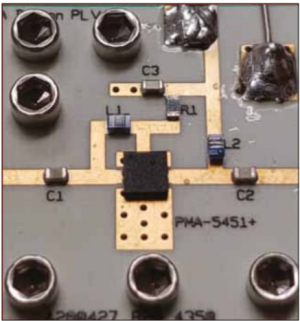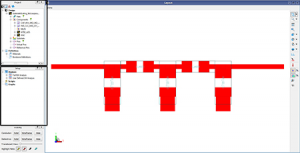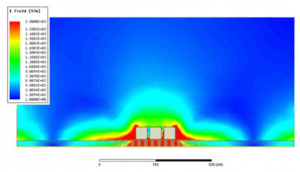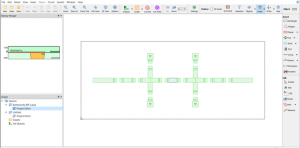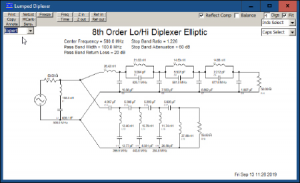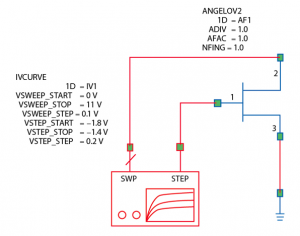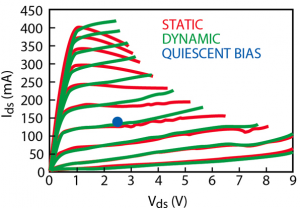Дополнительные материалы по программному обеспечению Modelithics
Уменьшение коэффициента шума монолитных малошумящих СВЧ-усилителей
СВЧ-электроника 2021'2
В статье описан способ улучшения характеристик малошумящих монолитных СВЧ-усилителей, аналогичных тем, что используются для дискретных транзисторных усилителей. Рассмотрен пример оптимизации МШУ на полосе 5 ГГц с целью уменьшения коэффициента шума ниже величины, приведенной в документации производителя.
Малошумящий усилитель (МШУ) – фундаментальный компонент цепи приема сигнала. Его задачей является усиление чрезвычайно слабых сигналов, принятых антенной приемника. Шум, вносимый МШУ, должен быть минимальным. По его величине принимают решение о пригодности антенны для проектируемой системы. Количественным показателем шума служит коэффициент шума, выраженный в децибелах и отражающий степень ухудшения отношения сигнал-шум при прохождении сигнала через схему. Малошумящие усилители выпускаются в виде монолитных СВЧ ИС (MMIC), и часто их характеристики значительно превосходят МШУ на основе дискретных транзисторов. Кроме того, интегральные усилители не требуют согласующих схем, поэтому их установка на плату значительно проще, чем дискретных усилителей.
Jump-Start EM/Circuit Co-Simulation with Keysight RFPro and Modelithics Models
Dan Schwarz, Chris DeMartino, HFE 2021'7
No question, electromagnetic (EM) analysis is critical for many of today’s designs. Specifically, for designs that include surface-mount components, it is often necessary to perform an EM/circuit co-simulation that combines circuit analysis of the component models with EM analysis of the surrounding interconnects. This article presents an EM/circuit co-simulation workflow made possible by combining Keysight Technologies’ RFPro EM environment with Modelithics® passive-component models.
Moving Beyond S-Parameter Files: Advanced Scalable and 3D EM Models for Passive Devices
Larry Dunleavy, Hugo Morales, Chris DeMartino, Isabella Bedford
S-parameter data files remain the most commonly available “model” for representing passive devices in the microwave industry. Physically motivated equivalent circuit models can be set up to scale accurately with part value, substrate properties and other parameters, such as solder pad dimensions. Still, such circuit models cannot generally account for electromagnetic (EM) coupling interactions between microwave components and between components and their surrounding shielding and interconnect environment. Consequently, full-wave EM analysis has become a crucial step at RF to account for such interactions. New technology, recently available in some EM simulators, allows for encrypting geometry and material details to protect vendor manufacturing IP and enable 3D EM models to be shared with a wider design community. These advances help designers reduce design risk and re-work and improve time-to-market for today’s increasingly compact and complex product form factors
EM Co-Simulation with Measurement-Based Models Leads to First-Pass Design Success
Chris DeMartinoEric Valentino
When simulating high-frequency filters with discrete passive components, it’s important to consider several factors to achieve simulation results that correspond to actual measured performance. One such aspect is the metallization that connects components together, as these metal interconnects impact the overall filter performance. In addition, component parasitics should be incorporated into a simulation to ensure that the simulated results accurately predict the filter’s response. Fortunately, electromagnetic (EM) simulation software, such as Sonnet Suites from Sonnet Software, makes it possible to incorporate metal interconnects into a simulation. However, EM simulations that include ideal passive-component models often expose a discrepancy between simulated and measured performance, because ideal component models don’t account for the parasitics that are present in real-world parts.
Nonlinear Modeling of a High Peak Power PIN Limiter
MWJ 2019'1
This article describes an innovative approach for accurate nonlinear modeling of a high peak power limiter circuit. The modeling approach involves “inside out” modeling of the individual constituent components, which are used to build a composite model. The constituent models include nonlinear models for discrete PIN diodes and linear models for other components, including the coaxial package, capacitors and microstrip circuits. The developed 8 to 18 GHz coaxial limiter model is validated against broadband S-parameter data through 20 GHz and with large-signal power compression measurements at 8 and 13 GHz. The diode models are also validated over temperature at 25°C and 100°C.
An Efficient and Accurate High-Frequency Diplexer, Duplexer, Triplexer, and N-Plexer Design Flow
HFE 2019'1
Diplexer, duplexer, triplexer, and N-plexer designs may include electrical and physical design requirements that are not only difficult and cumbersome, but at times may seem to be mutually exclusive. This is especially true at high frequencies, typically above ~100MHz and into the multi GHz range, where substrate and interconnect parasitic effects can significantly degrade performance and must be optimized without overburdening the designer or lengthening development time. This article presents an accurate and efficient flow for the design of these components employing a combination of Nuhertz Technologies filter solutions (FS), NI AWR software, specifically Microwave Office circuit design software, and Modelithics RF and microwave simulation models. This flow has been shown to overcome numerous physical/electrical design challenges of these devices at high frequencies.
Nonlinear Diode Models for Enhanced Simulation Accuracy
MWJ 2005'3
A library of robust models featuring substrate scalability and temperature dependence is now available for surface-mount diodes. The Modelithics Nonlinear Diode (NLD™) Library contains a compilation of measurement validated nonlinear diode models developed from I-V, C-V, small- and large-signal S-parameter characterization data. Over-temperature testing, combined with Modelithics’ patent-pending substrate-scalability features, extends the accuracy of nonlinear simulations over a wide range of assembly and operating conditions. No other set of diode models contains the same high levels of validation, accuracy, range of multi-variable applicability and documentation. The NLD Library is currently available in design kit format for Agilent’s Advanced Design System (ADS™).
Pulsed I-V for Nonlinear Modeling
MWJ 2003'3
Accurate, nonlinear, active device models are critical to achieving design success for circuits such as power amplifiers, oscillators and mixers, using computer-aided engineering (CAE) software such as Agilent Technologies' Advanced Design System (ADS™), Applied Wave Research's Microwave Office™, Eagleware's Genesys™ or Ansoft's Serenade™.
Больше статей на сайте Modelithics
